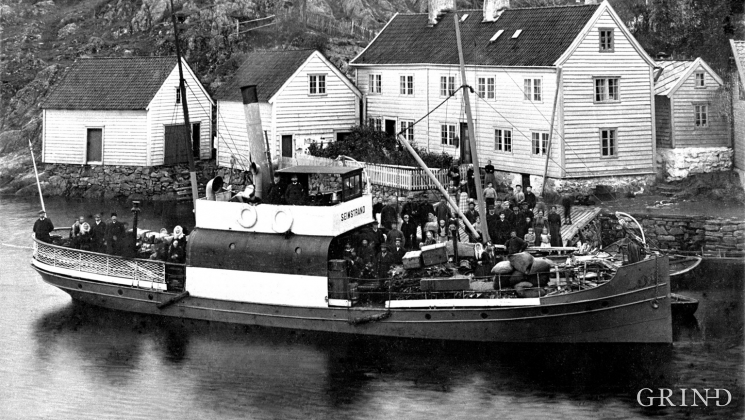Published: 29.01.2013 | Author: Per Jahn Lavik
D/S «Seimstrand» at bay in Salhus around 1906 (unknown, privately owned).
The first time Salhus is mentioned in written sources as a guesthouse place is at the beginning of the 1700s. At the courthouse of Arne Coastal Administration District, the tax collector asked if there were “any Merchant stand or Bourgeoisie in the District”. The answer was no, but there was still a little hostelry activity at the old inn for the numerous travellers. “To sit in Salhus” became a saying for those coming from Osterfjorden and Voss. The fjord was not easily crossed when the wind was strong.
In 1840 the tanner Hans Fossmark settled in Salhus and ran a tannery business which gradually became quite extensive. It was however only from 1859, after the establishment of Salhus Ttricotagefabrik, that the place started expanding. The factory was one of the very first hosiery factories established in Norway. As early as 1860, the first workers’ houses were ready, and in 1865 the next one. At the same time the factory was enlarged. A school was built in 1878 and Salhus developed into something of an industrial community with the textile industry as the main pillar.
Salhus
There is little left of the industrial activity in Salhus today, but the old factory buildings with workers’ houses and factory school, still stand. What points the way ahead is that a hosiery museum and textile centre are under establishment in the old factory buildings. These are planned as an active institution, which can have a limited production and be able to convey this part of industrial history to new generations; Norsk Trikotasjemuseum og tekstilsenter.
- Foss, T. & Sunde, H. (1986) Åsane fra bygd til bydel. Bergen, Eide.
- Fotland, N. (1945) Salhus i gamal og ny tid. Bergen, Grieg.
- Haukedal, E. (1956) Åsane: bygda og folkelivet: ei orientering. Bergen.
- Åsane bygdebok (1975). Bergen, Grieg.




